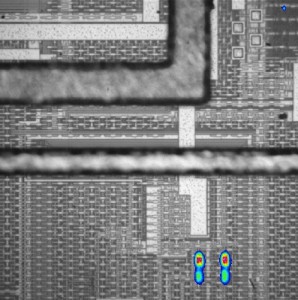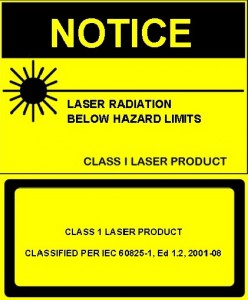XIVATM LSIM (Laser Signal Injection Microscopy):
XIVATM LSIM (Laser Signal Injection Microscopy) is used to locate shorts, junction defects, problem VIAs and other integrated circuit defects. XIVATM works by scanning a laser beam through a microscope lens, over an integrated circuit while monitoring the device I/V response for laser induced changes. By choosing the laser wavelength, different effects can be produced. Short wavelength lasers produce electron/hole pairs, (photo-carriers) in the semiconductor. These photon-generated carriers reveal failure sites in transistors and PN junctions.

1340 nm "Thermal" Laser Signal Injection Microscopy Easily Highlights Shorts and Other Ohmic Defects
Longer wavelength lasers (typically 1340 nm) induce localized heating as the laser is scanned over the DUT. The heating increases resistance. In areas where current is flowing, the increased resistance impacts current density. This technique reveals resistive and ohmic defects in IC devices. By this description, it is clear that QFI’s 1340 nm XIVATM is thermal laser signal injection technique. Front side and backside IC investigations are possible with XIVATM. Whether injecting photo-carriers of introducing heat, the laser directly impacts device impedance (usually resistance). The impedance change is evidenced in the aforementioned I/V curve shifts.
Various techniques have evolved for semiconductor fault location via laser techniques. The pioneer was OBIC in 1988. Since then, other techniques have appeared (i.e. LIVA, TIVA, IR-OBIRCH, and SEI). Each of these techniques generates photo carriers or local thermal heating to reveal defect locations. The techniques differ in how the circuit under test is biased and connected to the measuring amplifier. QFI’s patented XIVATM technique (eXternally Induced Voltage Alteration) was originally developed at OptoMetrix around the concept of constant voltage biasing coupled to constant current sensing. Constant voltage biasing was desirable for simplicity and common application, while constant current sensing provided superior signal-to-noise performance. QFI acquired OptoMetrix in 2006, and retained key technical staff in technology development roles.
Most semiconductor circuits are designed to operate on constant voltage. XIVATM constant voltage biasing simplifies set-up when using multiple analytical techniques on the DUT in a QuantumScopeTM system. Using the same biasing method on all techniques contributes to consistency of data. The constant voltage requirement is low frequency, but the XIVATM current sensing requirement is constant over a much shorter interval — the time required for the laser to pass over a defect. To implement the voltage biasing/sensing combination, a XIVATM filter is inserted in the bias supply to the DUT. At low frequencies the filter has no effect on the circuit, the voltage bias is properly constant. However, when the rapidly scanning laser encounters a defect, it causes a sudden change in the impedance of the DUT. The XIVATM filter supplies the required delta current over this brief interval, momentarily maintaining constant current. Coincidentally, the XIVATM filter removes external pick-up noise, yielding much greater sensitivity over earlier LSIM methods. XIVATM encompasses and extends all of the prior techniques of OBIC, LIVA, SEI, OBIRCH and TIVA. The XIVATM technique is the latest and most optimal LSIM technique for detecting and locating IC faults.
Product design efforts and applications work in conjunction with customers led to the development of new applications and measurement techniques. These additional techniques extended beyond the basic XIVATM concepts and drove the adoption of a more general measurement terminology — Laser Signal Injection Microscopy (LSIM). XIVATM LSIM can cover any electrical measurement of the IC, including dynamic measurements such as pass-fail response in a tester loop. The XIVATM equipment has a BNC user-input to the A/D card in the computer. Any signal can be plotted as a function of laser position in place of the normal XIVATM image.
QFI’s XIVATM LSIM is offered with an optional lock-in amplifier to increase sensitivity for weak signals. QFI estimates that 90% of LSIM detectable defects can be located using the standard XIVATM electronics without lock-in amplifier. For difficult low signal cases in electrically noisy devices, the lock-in amplifier provides significant sensitivity improvement. Lock-in improves sensitivity, but increases data acquisition time.
You are welcome to request additional information via the information request link:

